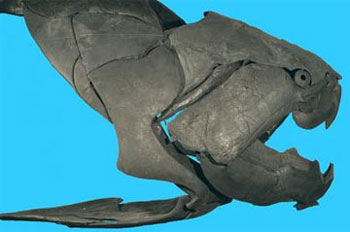Ancient fish had bite like Tyrannosaurus rex
Ancient fish had bite like Tyrannosaurus rex
mongabay.com
November 28, 2006
400-million years ago a 33-foot long, 4-ton fish terrorized the oceans with jaws that rivaled those of Tyrannosaurus rex, according to research published in the Royal Society journal Biology Letters on November 29.
The predator, called Dunkleosteus terrelli, had a bite with a force of 11,000 pounds and 80,000 pounds per square inch at its fang tip, allowing it to crush the shell of virtually an armored marine animal that lived during its time. The fish was also capable of opening its mouth very quickly to create a strong suction force to pull fast-moving prey into its mouth.
“The most interesting part of this work for me was discovering that this heavily armored fish was both fast during jaw opening and quite powerful during jaw closing,” said Mark Westneat, Curator of Fishes at The Field Museum and co-author of the paper. “This is possible due to the unique engineering design of its skull and different muscles used for opening and closing. And it made this fish into one of the first true apex predators seen in the vertebrate fossil record.”
 A photograph of the Dunkleosteus terrelli fossil skull upon which this study was based. Scientists created a biomechanical model to simulate the jaw’s function. From that they determined muscle mass and bite force. This ancient fish had a bite that exerted 11,000 pounds of force, the strongest bite of any fish ever, and one of the strongest bites of any animal, rivaling the bite of large alligators and Tyrannosaurus rex. The bladed dentition focused the bite force into a small area, the fang tip, at an incredible force of 80,000 pounds per square inch. Credit: Photograph by Michael LaBarbera, courtesy of The Field Museum |
Using a fossilized skull of a Dunkleosteus terrelli to recreate the musculature of the species, researchers determined “the ancient fish had the strongest bite of any fish ever, and one of the strongest bites of any animal, rivaling the bites of large alligators and Tyrannosaurus rex.”
“Dunkleosteus was able to devour anything in its environment,” said Philip Anderson, at the Department of Geophysical Sciences at the University of Chicago and lead author of the research. The bladed jaws, capable of ripping apart prey larger than its own mouth, is a feature sharks didn’t develop until 100 million years later.
“Overall, this study shows how useful mechanical engineering theory can be in studying the behavior of fossil animals,” he added. “We cannot actually watch these animals feed or interact, but we can understand the range of possible behaviors by examining how the preserved parts are shaped and connected to each other.”
This article is based on a news release from the Field Museum.